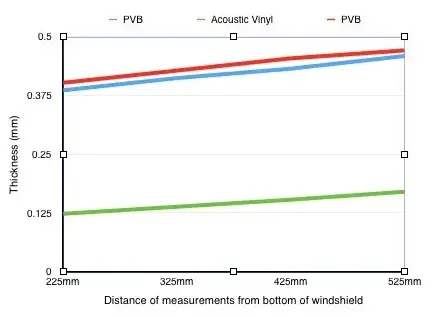Windshield glass thickness usually ranges from 3.5 to 5 millimeters. It enhances vehicle safety by improving structural integrity and impact resistance. The laminated design helps keep the glass intact during accidents, protecting passengers.
When discussing automotive safety, the windshield often takes a backseat in conversations about airbags, seat belts, and crash tests. However, the windshield is one of the most critical components of a vehicle’s structural integrity and safety. One of the lesser-known yet significant factors of a windshield is its thickness. Knowing windshield glass thickness not only gives insights into vehicle design but also provides a clearer understanding of its role in safety, durability, and performance.

Contents
What is Windshield Glass?
Windshield glass is a specialized form of glass known as “laminated safety glass.” This glass is designed specifically to resist shattering and to protect passengers from wind, debris, and other external elements. Laminated safety glass consists of two or more layers of glass with an interlayer of polyvinyl butyral (PVB), a type of plastic. This interlayer holds the glass together in case of an impact, preventing large shards from breaking off and injuring passengers.
Why is Windshield Thickness Important?
Windshield thickness plays a pivotal role in how well the glass performs under various conditions, including accidents, weather changes, and even everyday wear and tear. The thickness of the windshield impacts:
- Structural Integrity: The windshield contributes to the overall strength of the vehicle. A thicker windshield can enhance the car’s structural rigidity, especially in case of rollover accidents. It helps in keeping the roof from caving in and protects the occupants.
- Impact Resistance: The thickness of the windshield determines how well it can withstand forces such as flying debris or a collision with an animal or another vehicle. A thicker windshield generally offers better resistance to such impacts.
- Acoustic Properties: Windshields also play a role in noise reduction within the cabin. A thicker windshield can help dampen external noises, providing a quieter and more comfortable driving experience.
- Thermal Insulation: Windshield thickness can also contribute to insulating the vehicle’s cabin, maintaining interior temperatures by blocking out excess heat or cold.
- Wiper Efficiency: The thickness and smoothness of the windshield affect how efficiently wiper blades can clear water, snow, and debris. A windshield that’s too thin may flex under pressure, reducing the effectiveness of the wipers.
Standard Windshield Glass Thickness
While windshield glass thickness can vary depending on the vehicle manufacturer and model, the industry standard thickness typically falls between 3.1 to 6 millimeters. However, the most common thickness for the windshield is between 3.5 and 5 millimeters.
Here’s a breakdown of the different layers in a typical windshield:
- Outer Glass Layer: The external glass layer is generally around 1.5 to 2.5 millimeters thick. This layer faces the outside environment and is subjected to external factors such as weather, debris, and the sun’s UV rays.
- PVB Interlayer: The polyvinyl butyral layer sandwiched between the two glass layers is approximately 0.76 millimeters thick. This interlayer is the key to the windshield’s safety features, holding the glass together in case of a break.
- Inner Glass Layer: The interior glass layer, facing the vehicle’s occupants, is also around 1.5 to 2.5 millimeters thick. This layer is less exposed to external elements but still plays a crucial role in overall safety and clarity.
This standard thickness ensures the windshield meets safety regulations while providing durability, clarity, and noise reduction.
Factors That Influence Windshield Thickness
Several factors influence windshield thickness, including:
1. Vehicle Type
Different types of vehicles require different windshield thicknesses based on their use cases and safety needs. For example, commercial trucks, SUVs, and off-road vehicles typically have thicker windshields compared to smaller cars. These vehicles are more likely to encounter extreme conditions, such as high-speed debris impact or rollover risks, necessitating a more robust windshield.
2. Manufacturing Standards
Different car manufacturers have specific standards for windshield thickness, which are often determined by a combination of safety testing, performance data, and cost. Luxury cars, for instance, may have slightly thicker windshields to enhance soundproofing and improve the overall driving experience.
3. Safety Regulations
Governments and safety organizations around the world set minimum standards for windshield strength and durability. These regulations may vary by region, but they often dictate the thickness and quality of windshield glass that manufacturers must use.
In the U.S., the Federal Motor Vehicle Safety Standards (FMVSS) and the European Economic Commission for Europe (ECE) set stringent guidelines for the thickness, durability, and breakage patterns of automotive glass.
4. Environmental and Climate Considerations
In regions with extreme climates, windshields are often designed to handle significant changes in temperature. In cold climates, thicker windshields are beneficial as they resist the formation of cracks from freezing and thawing cycles, while in hot climates, thicker windshields help block more of the sun’s heat, preventing the cabin from overheating.
5. Windshield Design
Modern vehicles often come with sophisticated windshield designs, including curved glass and built-in features like defrosting elements, solar tinting, or even heads-up displays. These additional elements may require windshields to be thicker to accommodate the technology without compromising safety or visibility.

How Windshield Thickness Affects Replacement
When replacing a windshield, it’s crucial to ensure that the new glass matches the original thickness and quality. Fitting a windshield that is thinner than the original could compromise the vehicle’s structural integrity, while a significantly thicker windshield might not fit properly within the vehicle’s frame.
OEM vs. Aftermarket Windshields
There are two main types of replacement windshields: Original Equipment Manufacturer (OEM) and aftermarket. OEM windshields are made by the same manufacturer that produced the original glass for the vehicle. These windshields are often more expensive but are guaranteed to match the original specifications, including thickness.
Aftermarket windshields, on the other hand, are made by third-party manufacturers. While many aftermarket windshields meet the necessary safety standards, some may not match the original thickness and clarity of the OEM version. It’s important to ensure that the replacement windshield adheres to the same safety standards as the original.
Windshield Thickness and Safety
Thicker windshields provide better safety, but it’s important to understand that the thickness alone isn’t the only factor in windshield safety. The lamination process and the quality of materials used are just as critical. Proper installation is also essential. Even the best-quality, thickest windshield will fail to perform if it’s not installed correctly, leaving gaps that can weaken its ability to absorb impact.
During a crash, a properly installed windshield acts as a brace for the airbags. If the windshield is improperly installed, the airbags may not deploy correctly, potentially putting passengers at greater risk of injury.
Technological Advances in Windshield Glass
Over time, windshield technology has evolved significantly. Some newer innovations include:
- Acoustic Windshields: These windshields are slightly thicker and include a special sound-dampening interlayer that significantly reduces road and wind noise.
- Solar-Control Windshields: These windshields incorporate a reflective coating or interlayer that helps block ultraviolet (UV) and infrared (IR) rays, keeping the car cooler.
- Heated Windshields: Embedded with thin wires that conduct electricity, these windshields can defrost themselves in cold weather, making them ideal for cars in colder regions.
- Heads-Up Display (HUD) Windshields: Many modern vehicles have windshields designed to project important information like speed and navigation directions onto the glass, so drivers don’t need to look away from the road.
Frequently Asked Questions
Here are some FAQs about windshield thickness –
How thick should a windshield be?
A standard windshield is typically between 3.5 to 5 millimeters thick, though the exact thickness can vary based on the vehicle type and model.
Does windshield thickness affect safety?
Yes, thicker windshields can improve a vehicle’s structural integrity and offer better resistance to impacts, but proper lamination and installation are also critical for overall safety.
Can a windshield be too thick?
If a windshield is too thick, it may not fit properly in the vehicle’s frame, which could affect its ability to absorb impacts and protect passengers during a collision.
Is OEM glass always thicker than aftermarket glass?
Not necessarily. OEM and aftermarket glass often have similar thicknesses, but OEM glass is guaranteed to meet the vehicle’s original specifications, while aftermarket glass may vary slightly in thickness or clarity.
How can I tell if my windshield is the right thickness?
When replacing a windshield, it’s best to consult with a professional who can verify that the new glass matches the original specifications for your vehicle.
Conclusion
Windshield glass thickness is a crucial aspect of automotive safety, contributing to a vehicle’s structural integrity, impact resistance, and overall driving experience. While the standard thickness typically falls between 3.5 to 5 millimeters, various factors such as vehicle type, environmental conditions, and technological advances can influence the exact measurements.
When replacing or repairing a windshield, it’s important to choose high-quality, properly fitted glass to ensure continued safety on the road.